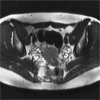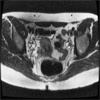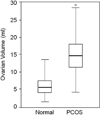Ovarian imaging by magnetic resonance in adolescent girls with polycystic ovary syndrome and age-matched controls
- PMID: 23292744
- PMCID: PMC3620938
- DOI: 10.1002/jmri.23992
Ovarian imaging by magnetic resonance in adolescent girls with polycystic ovary syndrome and age-matched controls
Abstract
Purpose: To compare ovarian morphology in adolescent girls with and without polycystic ovary syndrome (PCOS) using magnetic resonance imaging (MRI).
Materials and methods: In 21 adolescent girls (age 12-18 years) without and 19 adolescents with PCOS (diagnosis based on excessive hair growth and irregular menstrual cycles) ovarian volume, antral follicle count (AFC) per ovary, and follicle size were evaluated. MRI was performed at 1.5 T or 3 T and axial or angled-axial single-shot echo-train spin echo images of 6 mm slice thickness were acquired. In a subset of subjects, 2-mm images were also obtained. PCOS and non-PCOS groups were compared using mixed affects regression.
Results: Mean AFC per ovary and ovarian volume were substantially greater in PCOS subjects compared to non-PCOS subjects. Mean follicle size was similar between groups. Follicles exceeding 10 mm were seen in 2/19 PCOS subjects versus 9/21 non-PCOS subjects. Consistently higher follicle counts were detected in images obtained at 2 mm compared to 6-mm slice thickness.
Conclusion: In adolescence, MRI of the ovary reveals distinct differences between girls with and without PCOS. MRI may help evaluate young patients in whom transvaginal ultrasound is contraindicated.
Keywords: magnetic resonance; ovarian follicles; polycystic ovary syndrome.
Copyright © 2013 Wiley Periodicals, Inc., a Wiley company.
Figures





References
-
- Brown MA, Chang RJ. Polycystic ovary syndrome: clinical and imaging features. Ultrasound Q. 2007;23:233–238. - PubMed
-
- Chang R. Recommendations for the Early Recognition and Prevention of PCOS. In: Dunaif A, Chang R, Franks S, Legro R, editors. Polycystic Ovary Syndrome: Current Concepts and Controversies, From the Ovary to the Pancreas. Totowa: Humana Press; 2008. pp. 147–157.
-
- Rotterdam ESHRE/ASRM-Sponsored PCOS Consensus Workshop Group. Revised 2003 consensus on diagnostic criteria and long-term health risks related to polycystic ovary syndrome. Fertil Steril. 2004;81:19–25. - PubMed
-
- Rotterdam ESHRE/ASRM-Sponsored PCOS Consensus Workshop Group. Revised 2003 consensus on diagnostic criteria and long-term health risks related to polycystic ovary syndrome. Hum Reprod. 2004;19:41–47. - PubMed
-
- Pache TD, Wladimiroff JW, Hop WC, Fauser BC. How to discriminate between normal and polycystic ovaries: transvaginal US study. Radiology. 1992;183:421–423. - PubMed
Publication types
MeSH terms
Grants and funding
LinkOut - more resources
Full Text Sources
Other Literature Sources
Medical

